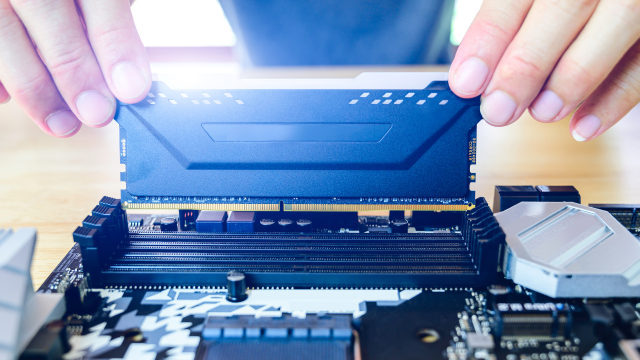Shortly before Forspoken came out, Square Enix’s new game that has been berated for cringy voice acting and gameplay that is fine at best, the developers announced an interesting specification recommendation for PC: a ‘recommended’ memory of 24GB, and 32GB for ‘ultra’ specs. So, how much RAM do you actually need in 2023?
Let me explain why this was so jarring. Up until now, ‘recommended’ specs have mostly floated around 16GB in the memory (RAM) category. Last year’s Call of Duty: Modern Warfare 2 developers recommended 12GB RAM, the developers of widely praised Elden Ring recommended 16GB RAM and the developers of A Plague Tale: Requiem recommended 16B RAM.
So to see Forspoken, a game that doesn’t really seem that much more graphically or sprite intensive than any of these other games, recommend 24GB RAM is a bit jarring — especially when that recommendation is for a 1440p 30fps resolution.
So, how much do you really need?
How much RAM do I need in 2023?
For the most part, 16GB RAM appears to be the standard still for if you’re doing anything more than casual computer things (like social media, browsing or basic word processing). If you’re going to use gaming as your benchmark, most graphics-intensive games still have 16GB RAM as the standard ‘recommended’ memory amount. If you’d like to bring it into context against consoles, both the Xbox Series X and the PlayStation 5 have 16GB RAM.
Going off the specs of the earlier mentioned major games (Call of Duty: Modern Warfare 2 2022, Elden Ring and A Plague Tale: Requiem), 16GB is the amount that most games with detailed graphics will typically ask for. With this being said, 16GB is best for PC gamers and enthusiasts running high-end programs (like large spreadsheets or across dozens of browser tabs). Note though that this is subject to change as games become more resource-demanding, as they have in the past.
If you’re just going to be doing really basic stuff with your computer, like social media, taking notes, using things like Microsoft Word and browsing the internet, then 8GB is best for casual PC use. This is likely an area where you could save some money.
Any higher than these numbers and things can get muddy. Last year, when I upgraded from 16GB to 32GB RAM, I noticed a performance boost when I had multiple Google Chrome tabs open across different monitors, but not a performance boost when playing games. I was, however, able to run programs outside of my game (such as Spotify or Chrome with a Twitch stream open) without any extra lag after the upgrade.
It helps the computer run smoother, but it’s unlikely to generate massively improved gaming performance on its own if you’re upgrading from 16GB to 32GB.
Testing Games exemplifies this well in the below video. The differences in FPS you’ll see between 16GB and 32GB are marginal at best, but the jump from 8GB to 16GB RAM is far more important.
With this said, 32GB RAM makes the most sense for professionals (as does 64GB and onward). If you’re using a high-end computer to have dozens of resource-demanding programs running at once, such as Outlook, Photoshop, Excel, Illustrator and other high-spec applications, having more memory should keep your computer going for longer without freezing or acting slow.
But what about RAM speed?
So if GB indicates RAM storage capacity, what does MHz mean? The MHz part of the RAM stick indicates how fast it is, but don’t let this overcomplicate your buying process.
PC Gamer noted between a 2-16 FPS performance increase depending on the RAM MHz speed, but as you start to get into high speeds, the performance increase lowers into near irrelevancy.
For this reason, I recommend buying Memory with a 3,200MHz speed for most people, however, you could go lower or higher depending on your need. Like we said earlier, it depends on if you’re a casual user, enthusiast or professional.
Whatever you do, you’re better off saving money as it’ll let you spend more on other components.
What does RAM do?
While your hard drive lets you store data that you can access at anytime, RAM (or memory) stores data that needs to be readily available in the short-term, such as the data that lets you open, read and interact with programs. It’s an important part of any computer, and translates to your computer’s ability to have multiple processes operating at once.
RAM resets every time a computer is restarted or turned off, dumping the memory that was used during its last operation. For this reason, you can’t use your memory as a storage drive.
how to check your RAM
Checking your RAM on a Windows 10 or Windows 11 PC is easy:
- Press the Windows key
- Type ‘RAM’ and click ‘View RAM info’
- Your RAM will display as ‘Installed RAM’
This is useful to quickly check if your RAM’s operating as intended, especially after an upgrade.
If you’d like to check your RAM’s speed:
- Open Task Manager (CTRL + Shift + ESC)
- Open the performance tab (the square that looks like a heart rate monitor)
- Click Memory
- Your RAM speed will display beside ‘Speed’
If your RAM isn’t operating at the speed it says it’s capable of, then you’ll need to activate it inside your BIOS by enabling XMP.
